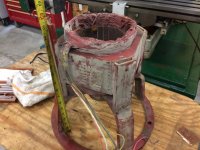rwskinner
Aluminum
- Joined
- Sep 22, 2015
- Location
- Somewhere in Texas
I need some advice on making a fixture to hold a part in the lathe so I can do some light machining on one end. Here are the details...
I have 19x80 Leblond and need to machine a feature on one end of a generator stator. The stator housing is about 10" long and has windings sticking out about 1.5" on each end. It's close to 8" OD but I can not chuck up on the O.D. of the part due to the windings sticking out each end, not allowing it to get close enough to the jaws.
The stator does have a nice bore that measures very uniform and is close to 6" ID.
I have a big chunk of heavy wall 4130 (6.250 OD x 3.750 ID) and I was thinking about machining a one ended tapered mandrel of sorts.
My thinking is, if I put a light taper on the mandrel, I could lightly press it into the stator. The length inside the stator is close to 6".
The overhang doesn't bother me that much as I have fairly light cuts to make, however there is no way to secure the stator to the mandrel other than the taper friction fit.
Does this have merit? What would be a good taper to shoot for that would be self centering and wedge well enough to secure the part?
No room for a tailstock center and can't use a steady rest.
I have 19x80 Leblond and need to machine a feature on one end of a generator stator. The stator housing is about 10" long and has windings sticking out about 1.5" on each end. It's close to 8" OD but I can not chuck up on the O.D. of the part due to the windings sticking out each end, not allowing it to get close enough to the jaws.
The stator does have a nice bore that measures very uniform and is close to 6" ID.
I have a big chunk of heavy wall 4130 (6.250 OD x 3.750 ID) and I was thinking about machining a one ended tapered mandrel of sorts.
My thinking is, if I put a light taper on the mandrel, I could lightly press it into the stator. The length inside the stator is close to 6".
The overhang doesn't bother me that much as I have fairly light cuts to make, however there is no way to secure the stator to the mandrel other than the taper friction fit.
Does this have merit? What would be a good taper to shoot for that would be self centering and wedge well enough to secure the part?
No room for a tailstock center and can't use a steady rest.






 I think your insurance company will be pleased you're not going to swing it based on the the setup you originally described.
I think your insurance company will be pleased you're not going to swing it based on the the setup you originally described.




 Not quite as sketchy as you were proposing initially, but still dodgy in my opinion, and all good until one day the tool chips or something, digs in and there's a mighty crash. I pulled a job from a chuck a few months back, I can't even recall the details now, but i hadn't done it for years and it was a good reminder to respect stick out!
Not quite as sketchy as you were proposing initially, but still dodgy in my opinion, and all good until one day the tool chips or something, digs in and there's a mighty crash. I pulled a job from a chuck a few months back, I can't even recall the details now, but i hadn't done it for years and it was a good reminder to respect stick out!